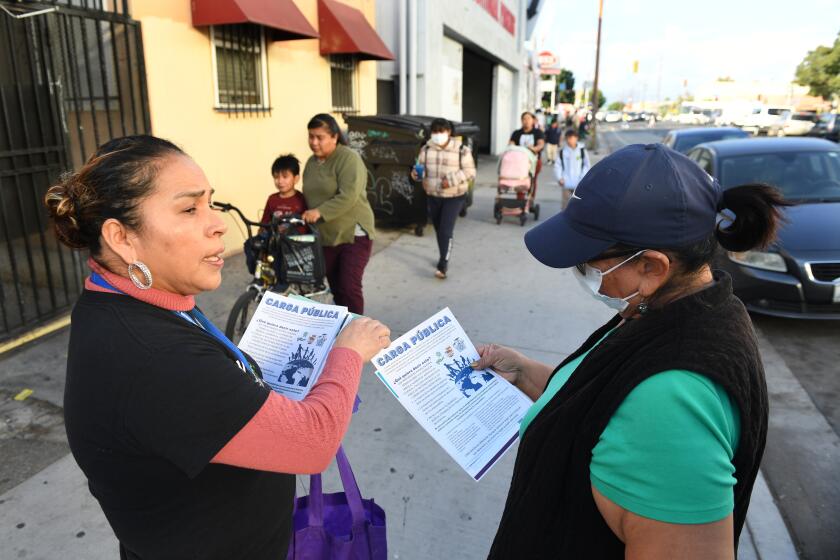Easy as Prop. 1, 2, 3
- Share via
FOR A CALIFORNIA voter, becoming confused doesn’t require wading through almost 200 pages of ballot measure text, argument, counterargument and explanation. It’s enough to just try figuring out the numbering. If the first measure on the ballot is Proposition 1A, for example, and there are 13 of them, why is the last one Proposition 90 instead of 1M? Besides, voters just approved Proposition 1A two years ago. How can it be back? If we passed Proposition 209 a decade ago, shouldn’t we be well into the 700s by now? And on the Los Angeles city ballot, why do we go from Proposition H to J, without any I, then zoom all the way to R?
There are answers, and one or two of them even make sense.
State proposition numbering used to start over at 1 with every election. The only way voters would ever have to deal with, say, Proposition 48 was to have 48 measures on a single ballot. By the way, Californians did just that in 1914. Voters made their way through four dozen measures, including one making an early stab at Prohibition (it failed), another barring poll taxes (it passed) and another criminalizing business operations on Sunday, the Sabbath (it failed). The next election, everything started over with Proposition 1.
But the proposition-numbering world changed in 1982, when puzzled voters opened their ballot pamphlets and saw a water appropriations measure called Proposition 13. Wasn’t Proposition 13 the historic property tax revolt from back in 1978? Shouldn’t its number be retired, sort of like a baseball Hall of Famer’s uniform number? Nice idea, but the Legislature instead decreed that ballot measure numbers would be sequential through the years. That’s what made a jail bond, first up on the ballot in 1984, Proposition 16 instead of Proposition 1. It passed, by the way.
The years went by, and the numbers climbed. We got up to Proposition 49 with a 1986 constitutional amendment prohibiting political parties from endorsing candidates in nonpartisan elections. Another election, later that year, brought us the Safe Drinking Water and Toxic Enforcement Act with its now-familiar Proposition 65 warnings. Proposition 103 in 1988 was insurance reform. In 1994, we had Proposition 187, the measure restricting services for illegal immigrants, which passed but was struck down by the courts and dropped on appeal. By June 1998, we had gotten up to Proposition 227, which ended most bilingual education. The sky was the limit. Waiting for Proposition 300 was like waiting for the Dow to break 12,000.
But the Legislature stepped in once more, with Elections Code Section 13117, which started everything over at Proposition 1, starting with the November 1998 election, and instituted a 10-year cycle. This year we’re back up to 90, but the 10-year period is up next year and the numbers will again reset.
That still doesn’t explain why the first five propositions on the Nov. 7 ballot are numbered 1A through 1E. Again, it’s the Legislature at work. Our lawmakers can, and often do, cut in line with their own ballot measures. They can instruct the secretary of state to number them with 1, plus a letter. The idea, presumably, is that voters will be in a more generous mood at the top of the ballot and won’t get cranky until they turn their attention to the various petition-created initiatives.
This year’s 1A through 1E make up the bond package deal brokered by the governor and the Legislature, except that 1A is not a bond but a spending directive. Proposition 84, which is a bond, was supposed to be part of the deal; it came too late to be included, but proponents had been gathering signatures and got it on the ballot as an initiative.
When it comes to Los Angeles city measures, it’s anything goes. Those put on the ballot by the City Council, as most are, can be called pretty much whatever the council president wants to call them, using names or numbers. And although the city clerk’s website calls them Measure H, Measure J and Measure R, on the ballot they are called propositions. Proposition H is not a nonprescription cream sold in a yellow box but a housing bond. Get it? H for “housing.” Proposition R, which would relax term limits and enact ethics reforms, is named for “reform,” although opponents might have preferred T for “term limits.” Proposition J would amend an earlier bond measure for building fire stations.
But why J? Well, really -- why not?
More to Read
Get the L.A. Times Politics newsletter
Deeply reported insights into legislation, politics and policy from Sacramento, Washington and beyond. In your inbox twice per week.
You may occasionally receive promotional content from the Los Angeles Times.











